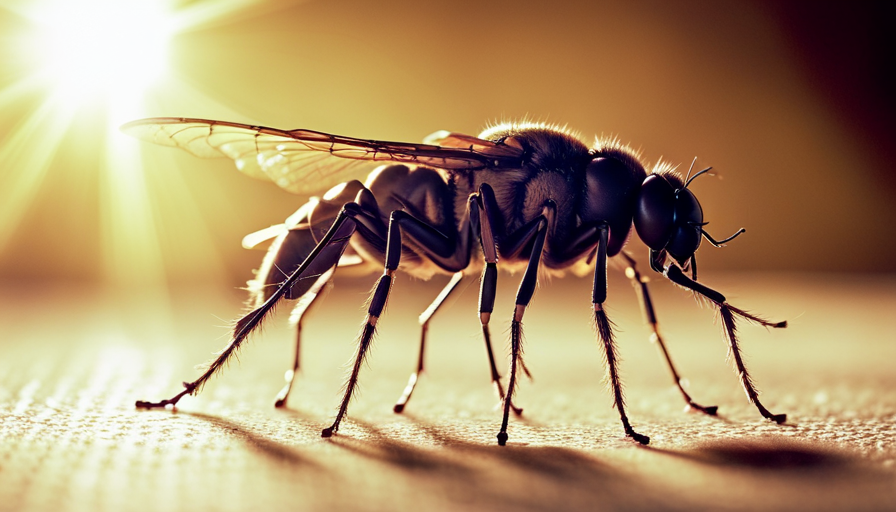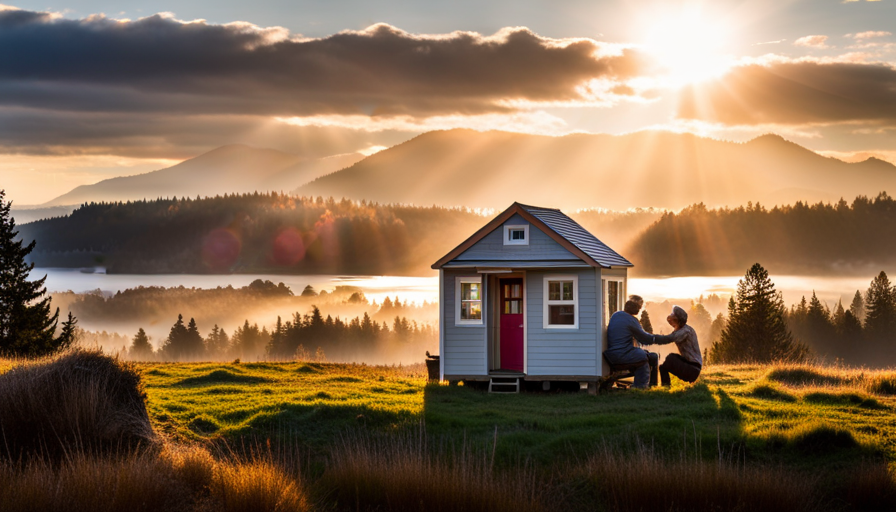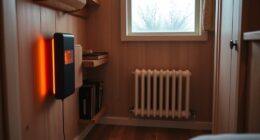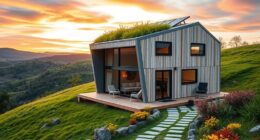Did you know that the average American household consumes about 10,399 kilowatt-hours of electricity per year? That’s enough energy to power a small village!
But what about tiny houses? How do these compact dwellings, often no bigger than 400 square feet, manage to meet their utility needs?
In this article, I will delve into the fascinating world of tiny house utilities and explore the ingenious ways in which these miniature homes source and manage their electricity, water, sewage, heating and cooling, gas, and propane.
From off-grid options and solar power to innovative waste management solutions and DIY plumbing and wiring tips, we will uncover the secrets behind the seamless integration of these essential services into the tiny house lifestyle.
Join me on this journey as we discover the cost-effective and sustainable benefits of tiny house utilities and learn how these pint-sized dwellings are revolutionizing the way we live.
Key Takeaways
- Tiny houses have ingenious ways of meeting their utility needs, including sourcing and managing electricity, water, sewage, heating and cooling, gas, and propane.
- Solar power is a popular option for electricity in tiny houses, and off-grid options like wind turbines and hydroelectric systems can enhance self-sufficiency.
- Tiny houses utilize rainwater collection and water tanks for water supply, as well as water filtration systems to ensure clean and safe water.
- Tiny houses maximize efficiency with energy conservation techniques, renewable energy sources, energy-efficient appliances, LED lighting, and proper insulation and sealing.
Understanding the Basics of Tiny House Utilities
Imagine a tiny house, nestled in the heart of nature, effortlessly tapping into the grid for its basic utilities. When it comes to managing waste, tiny houses have various options.
Composting toilets are a popular choice as they turn human waste into nutrient-rich compost, which can be safely used in gardens. Greywater systems are another efficient way to manage waste by diverting water from sinks and showers to be filtered and reused for tasks like watering plants or flushing toilets.
To power a tiny house, alternative energy sources are often utilized. Solar power is a particularly popular option, as it harnesses the sun’s energy to generate electricity. Solar panels are installed on the roof, capturing sunlight and converting it into usable power. This renewable energy source not only reduces utility bills but also minimizes the environmental impact. Additionally, off-grid options such as wind turbines or hydroelectric systems can be implemented to further enhance the self-sufficiency of a tiny house.
Transitioning into the next section, electricity plays a crucial role in powering a tiny house. Off-grid options and solar power provide reliable and sustainable solutions for tiny house owners.
Electricity: Off-grid Options and Solar Power
When it comes to off-grid options for electricity in a tiny house, two key points to consider are solar panels with battery systems and wind turbines.
Solar panels are a popular choice for tiny houses as they harness the power of the sun to generate electricity. Battery systems are then used to store this electricity for use when the sun is not shining.
Another option for off-grid electricity is wind turbines. These devices convert the wind’s kinetic energy into electricity, making them a great alternative for areas with consistent wind patterns.
Additionally, hydroelectric power can also be considered as a sustainable off-grid option for generating electricity in a tiny house. By harnessing the energy of flowing water, such as a nearby stream or river, hydroelectric systems can produce a reliable source of power.
Solar panels and battery systems
Solar panels and battery systems are essential for tiny houses to generate and store their own electricity. Solar panels installation is a crucial aspect of setting up a tiny house’s electrical system. It involves mounting the panels on the roof or any other suitable location with maximum exposure to sunlight. Proper installation ensures optimal energy absorption and conversion into usable electricity.
Maintaining the battery system is equally important. This involves regular checks on the battery’s charge level, ensuring proper ventilation, and preventing overcharging or deep discharge. It is also crucial to monitor the battery’s health and replace it when necessary to ensure a continuous power supply.
In order to provide a more comprehensive understanding, the following table breaks down the different components involved in solar panels and battery systems:
| Component | Function | Importance |
|---|---|---|
| Solar panels | Capture sunlight and convert it into electricity | Essential for generating power in a tiny house |
| Charge Controller | Regulates the flow of electricity from the solar panels to the batteries | Protects the batteries from overcharging or deep discharge |
| Batteries | Store the electricity generated by the solar panels | Provide a continuous power supply when sunlight is not available |
| Inverter | Converts the stored DC electricity into AC electricity | Allows the use of standard household appliances |
Transitioning to the next section, wind turbines and hydroelectric power also offer alternative methods for generating electricity in a tiny house setup.
Wind turbines and hydroelectric power
To power your tiny home efficiently, you can harness the natural forces of wind and water with wind turbines and hydroelectric power.
Wind turbines are a great option for generating electricity in areas with strong winds. Proper maintenance is crucial to ensure their optimal performance. Regularly inspecting the turbine blades for any damage or wear, and keeping them clean from debris, is essential. Additionally, lubricating the moving parts and checking the electrical connections will help prevent any malfunctions.
On the other hand, hydroelectric power generation utilizes the force of flowing water to generate electricity. By diverting a portion of a nearby stream or river, you can install a small turbine that will turn the flowing water into electrical energy. It’s important to consider the environmental impact and any necessary permits when implementing hydroelectric power in your tiny home.
Transitioning to the subsequent section about water sourcing and managing water supply, it is crucial to explore sustainable options for a well-rounded off-grid living experience.
Water: Sourcing and Managing Water Supply
When it comes to sourcing and managing water supply in a tiny house, there are two key points to consider. One is collecting rainwater and using water tanks. This allows for the collection and storage of rainwater, which can then be used for various purposes such as washing dishes, showering, and watering plants. The other point is installing water filtration systems. This ensures that the collected rainwater or any other water source is clean and safe for consumption, removing any impurities or contaminants.
Collecting rainwater and using water tanks
If you want to really embrace sustainable living in your tiny house, you can rely on collecting rainwater in water tanks that will quench your thirst forevermore.
Rainwater harvesting is a technique that involves capturing and storing rainwater for later use. It is a great way to conserve water and reduce your reliance on traditional water sources.
When it rains, the water is collected from the roof of the tiny house and directed into a storage tank. The collected rainwater can then be used for various purposes such as drinking, cooking, and even showering.
Installing water filtration systems ensures that the rainwater is safe for consumption by removing any impurities or contaminants.
By implementing rainwater harvesting and water conservation practices in your tiny house, you can minimize your environmental impact and live a truly sustainable lifestyle.
Installing water filtration systems
Consider installing water filtration systems in your tiny house to ensure that the rainwater you collect is safe and clean for all your daily needs. Water purification is essential to remove any impurities and contaminants that may be present in rainwater.
Filtration systems play a crucial role in this process by effectively removing particles, sediments, and harmful bacteria, providing you with clean and drinkable water. There are various types of water filtration systems available, such as activated carbon filters, reverse osmosis systems, and UV sterilizers.
Activated carbon filters are effective in removing chlorine, sediments, and unpleasant tastes and odors. Reverse osmosis systems use a membrane to remove impurities, including heavy metals. UV sterilizers use ultraviolet light to kill bacteria and other microorganisms.
By installing these filtration systems, you can have peace of mind knowing that the water you use is safe and pure.
Moving on to sewage: innovative solutions for waste management, it is important to address the issue of waste disposal in tiny houses without using conventional sewage systems.
Sewage: Innovative Solutions for Waste Management
To efficiently manage waste in your tiny house, you can explore innovative solutions for sewage disposal. One such solution is the use of innovative composting systems. These systems utilize organic materials, such as sawdust or coconut coir, to break down waste into compost. This compost can then be safely used as fertilizer for plants.
Not only does this method eliminate the need for traditional plumbing systems and septic tanks, but it also promotes sustainability and reduces environmental impact.
Another option for waste management in a tiny house is the use of eco-friendly toilets. These toilets are designed to use minimal amounts of water or even no water at all. Some models utilize a vacuum flush system, while others use a combination of air pressure and gravity to dispose of waste. These toilets are not only efficient in terms of water usage, but they also help reduce the amount of waste that ends up in landfills.
Transitioning into the subsequent section about heating and cooling, efficient climate control is another important aspect to consider in a tiny house. By utilizing energy-efficient heating and cooling systems, such as mini-split heat pumps or radiant floor heating, you can effectively maintain a comfortable temperature inside your tiny house without consuming excessive energy.
Innovative composting systems and eco-friendly toilets offer practical and sustainable solutions for waste management in a tiny house. By incorporating these methods, you can efficiently dispose of waste while minimizing your environmental impact.
Moving forward, efficient climate control systems will ensure a comfortable living environment inside your tiny house.
Heating and Cooling: Efficient Climate Control
When it comes to efficient climate control in a tiny house, there are several key points to consider.
One option is mini-split air conditioning and heating units, which provide both cooling and heating capabilities in a compact size.
Another option is wood-burning stoves, which not only provide warmth but also add a cozy ambiance to the space.
Lastly, radiant floor heating is a popular choice that uses hot water or electric coils installed beneath the floor to evenly distribute heat throughout the tiny house.
Mini-split air conditioning and heating units
Installing a mini-split unit in your tiny house will keep you comfortable year-round without sacrificing valuable space. Mini-split air conditioning and heating units, also known as ductless HVAC systems, are energy-efficient appliances that provide both heating and cooling.
These units consist of an indoor evaporator unit and an outdoor condenser unit connected by a refrigerant line. The indoor unit is mounted on a wall or ceiling and blows conditioned air into the room, while the outdoor unit dissipates heat or cold air.
Mini-split units are compact and require no ductwork, making them ideal for tiny houses with limited space. They offer precise temperature control and can be easily adjusted to maintain a comfortable environment.
When it comes to heating options, wood-burning stoves and radiant floor heating are alternative choices that provide warmth and coziness.
Wood-burning stoves and radiant floor heating
Stay warm and cozy in your tiny abode with the rustic charm of a wood-burning stove or the luxurious comfort of radiant floor heating. Wood-burning stoves are a popular choice for tiny homes due to their efficient heat output and ability to utilize renewable resources. To ensure safety and efficiency, it’s important to properly install and maintain wood-burning stoves. Here are five key considerations:
- Choose a stove that’s appropriately sized for your space.
- Install a chimney with proper insulation to prevent heat loss.
- Use energy-efficient insulation in your tiny house to retain heat.
- Consider a stove with a catalytic converter to reduce emissions.
- Regularly clean and inspect your stove and chimney to ensure optimal performance.
By combining a wood-burning stove with energy-efficient insulation, you can effectively heat your tiny home without relying solely on traditional heating methods.
Transitioning into the subsequent section about ‘internet and communication: staying connected in a tiny home’, you can also ensure a comfortable and connected lifestyle in your cozy abode.
Internet and Communication: Staying Connected in a Tiny Home
To ensure connectivity in a tiny home, residents can easily set up internet and communication services. Staying connected is crucial in today’s world, and there are several internet options available for tiny homes.
One popular choice is a traditional wired internet connection, which requires a physical connection to the home through cables. This can be achieved by contacting a local internet service provider (ISP) and requesting their services.
Another option is wireless internet, which relies on cellular networks to provide internet access. This can be a convenient choice for those who are constantly on the move or live in remote areas. To set up wireless internet, a tiny home owner can purchase a mobile hotspot device or use their smartphone as a hotspot.
Additionally, satellite internet is an option for those who live in areas where wired or wireless connections are not available. By installing a satellite dish, residents can access the internet through a satellite signal.
With these various options, staying connected in a tiny home is easily achievable.
Moving on to gas and propane: cooking and heating options, there are several ways to ensure a comfortable living environment in a tiny home without relying on traditional utilities.
Gas and Propane: Cooking and Heating Options
With the flicker of a flame, the warmth and aroma of a home-cooked meal fill the air in a tiny abode powered by gas and propane. When it comes to cooking and heating options in a tiny house, the choice between gas and electric appliances is an important consideration. While electric appliances are more common in traditional homes, gas appliances have their advantages in a tiny house. They provide instant heat and precise temperature control, making them ideal for small spaces. Additionally, gas appliances can operate during power outages, ensuring that you can still cook and stay warm even when the electricity is down.
To better understand the differences between gas and electric appliances, let’s take a look at the following table:
| Gas Appliances | Electric Appliances |
|---|---|
| Instant heat | Slower heating time |
| Precise temperature control | Limited temperature control |
| Operate during power outages | Require electricity |
When it comes to propane tank storage, it’s important to consider both safety and space. Propane tanks should be stored outside the tiny house in a well-ventilated area away from any potential sources of ignition. Many tiny house owners choose to install a propane tank locker or cabinet to securely store their tanks.
In the next section, we will explore energy conservation techniques to maximize efficiency in a tiny home. By implementing these strategies, you can further reduce your environmental footprint and save on utility costs.
Energy Conservation: Maximizing Efficiency in a Tiny Home
By implementing energy conservation techniques, you can create a cozy and eco-friendly haven in your compact living space. In a tiny home, maximizing space utilization is crucial, and this concept extends to energy efficiency as well.
One of the most effective ways to conserve energy in a tiny house is by utilizing renewable energy sources. Solar panels are a popular choice for tiny homeowners, as they can generate electricity to power various appliances and lighting fixtures. Additionally, wind turbines can be installed to harness the power of the wind, further reducing reliance on traditional energy sources.
To maximize the efficiency of your tiny home’s energy consumption, it’s essential to invest in energy-efficient appliances. Look for appliances with the Energy Star certification, which indicates that they meet strict energy efficiency standards. LED lighting is another great option for tiny homes, as it consumes significantly less energy compared to traditional incandescent bulbs.
Furthermore, proper insulation and sealing can greatly contribute to energy conservation. By insulating your tiny home using high-quality materials, you can minimize heat loss during colder months and reduce the need for excessive heating. Sealing any gaps or cracks will also prevent drafts and maintain a comfortable temperature inside your tiny house.
Energy conservation in a tiny house involves maximizing space utilization and utilizing renewable energy sources. By investing in energy-efficient appliances, proper insulation, and sealing, you can create an eco-friendly and energy-efficient living space.
Transitioning into the subsequent section about plumbing and wiring, let’s explore some DIY tips for setting up utilities in your tiny house.
Plumbing and Wiring: DIY Tips for Tiny House Utilities
Maximizing efficiency in a tiny home’s plumbing and wiring is like weaving a tapestry of functionality and convenience. When it comes to DIY plumbing and wiring tips for tiny homes, there are several key considerations to keep in mind.
Here are some important points to remember:
-
Utilize PEX piping: PEX piping is flexible, durable, and easy to install, making it an ideal choice for tiny house plumbing. Its versatility allows for efficient routing and reduces the risk of leaks.
-
Use compact fixtures: Opt for compact fixtures that are specifically designed for small spaces. These fixtures not only save space but also conserve water by reducing flow rates.
-
Install low-flow faucets and showerheads: Low-flow faucets and showerheads are essential for water conservation in a tiny home. These fixtures reduce water consumption without compromising on performance.
-
Consider energy-efficient lighting solutions: LED lights are a great choice for tiny homes as they consume significantly less energy compared to traditional incandescent bulbs. Additionally, installing dimmer switches can help further reduce energy usage.
With these DIY plumbing and wiring tips, you can ensure that your tiny home is equipped with efficient and sustainable utilities. Transitioning into the next section about the benefits of tiny house utilities, let’s explore the cost and sustainability aspects of these innovative solutions.
Cost and Sustainability: The Benefits of Tiny House Utilities
To fully understand the advantages of tiny house utilities, imagine the cost savings and environmental benefits that come with using compact fixtures and energy-efficient lighting solutions.
When it comes to cost effectiveness, tiny house utilities are a game-changer. The smaller size of a tiny house means that less energy is needed to power and heat the space. This translates into lower monthly utility bills and long-term savings. Additionally, the use of energy-efficient appliances and fixtures further reduces energy consumption, resulting in even greater cost savings.
Not only do tiny house utilities save you money, but they also have a positive environmental impact. The reduced energy consumption means less reliance on fossil fuels and a decreased carbon footprint. By using energy-efficient lighting solutions, such as LED bulbs, you can significantly reduce electricity usage. Furthermore, tiny houses often employ sustainable practices, such as rainwater harvesting systems and composting toilets, which further minimize their environmental impact.
The cost effectiveness and environmental impact of tiny house utilities cannot be underestimated. By utilizing compact fixtures and energy-efficient solutions, you can save money on your monthly utility bills and reduce your carbon footprint. So, if you’re considering downsizing to a tiny house, rest assured that you won’t only be saving money but also contributing to a more sustainable future.
Frequently Asked Questions
Can a tiny house be connected to a traditional utility grid for electricity?
Yes, a tiny house can be connected to a traditional utility grid for electricity. Just like a small seed grows into a mighty tree, the tiny house can tap into the power grid, receiving a steady flow of electricity.
This connection allows for a reliable and convenient source of power. However, for those seeking a more independent lifestyle, off-grid options for electricity, such as solar panels or wind turbines, can be explored.
What are some alternative options for heating a tiny house?
When it comes to heating options for a tiny house, two popular choices are propane and wood burning stoves.
Propane is a convenient and efficient option, as it can be easily stored and provides consistent heat.
On the other hand, wood burning stoves offer a more traditional and cozy ambiance, but require a constant supply of firewood.
Both options have their advantages and disadvantages, so it ultimately depends on personal preference and the specific needs of the tiny house owner.
How much does it cost to install solar panels on a tiny house?
The cost of installing solar panels on a tiny house depends on various factors such as the size of the system, location, and specific energy needs. On average, a 2-3 kW solar panel system can cost between $5,000 to $10,000.
The benefits of solar panels include reduced electricity bills, environmental friendliness, and the potential for off-grid living. However, drawbacks include the initial high cost, potential maintenance expenses, and limitations in areas with limited sunlight.
Are there any regulations or permits required for installing plumbing in a tiny house?
When installing plumbing in a tiny house, it’s important to consider the regulations and permits that may be required. These requirements vary depending on the location and local building codes. Generally, permits are necessary for any plumbing work, including the installation of fixtures, pipes, and water systems.
It’s crucial to consult with local authorities and obtain the necessary permits to ensure compliance with regulations and avoid any legal issues.
Can a tiny house be connected to a municipal water supply?
Connecting a tiny house to a municipal water supply is possible through a municipal water hookup. This option provides a reliable and consistent water source for your tiny home. However, if you prefer to be off the grid, there are alternative water options available.
These include rainwater collection systems, well water, or even using a water delivery service. It’s important to research and consider the best option based on your location and personal preferences.
Conclusion
In conclusion, living in a tiny house doesn’t mean sacrificing modern comforts. With careful planning and innovative solutions, utilities can be efficiently managed in these small spaces.
From off-grid options for electricity to sourcing and managing water supply, there are various ways to meet your needs. Additionally, creative solutions for waste management and efficient climate control ensure a comfortable living environment.
By maximizing energy conservation and utilizing DIY tips for plumbing and wiring, you can enjoy the benefits of tiny house living while minimizing costs and promoting sustainability.
So why wait? Start exploring the possibilities of tiny house utilities today!
Hi, I’m Emma. I’m the Editor in Chief of Tiny House 43, a blog all about tiny houses. While tree houses are often associated with childhood, they can be the perfect adult retreat. They offer a cozy space to relax and unwind, surrounded by nature. And since they’re typically built on stilts or raised platforms, they offer stunning views that traditional homes simply can’t match. If you’re looking for a unique and romantic getaway, a tree house tiny house might just be the perfect option.










